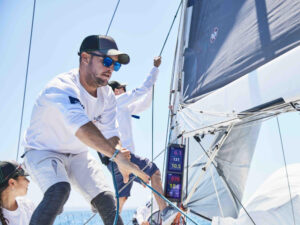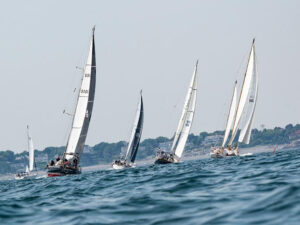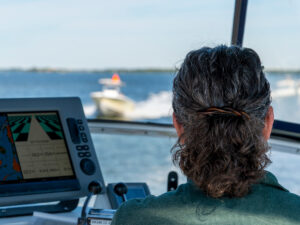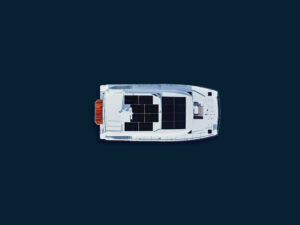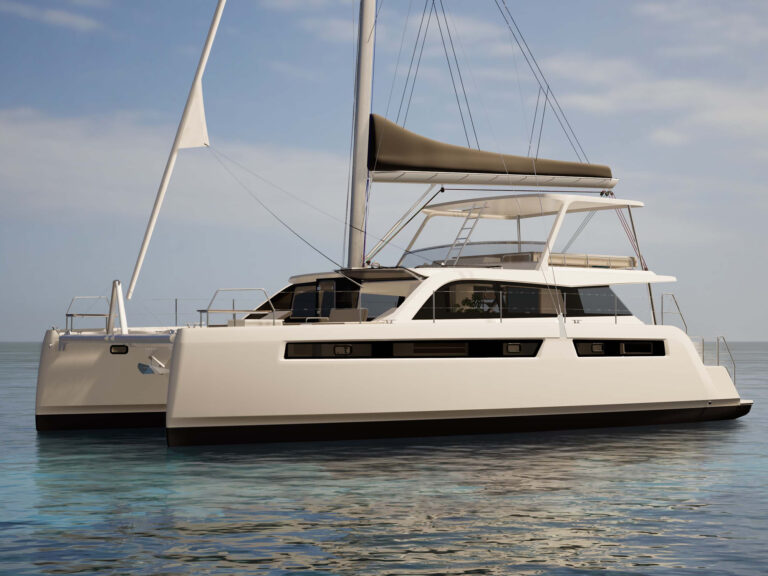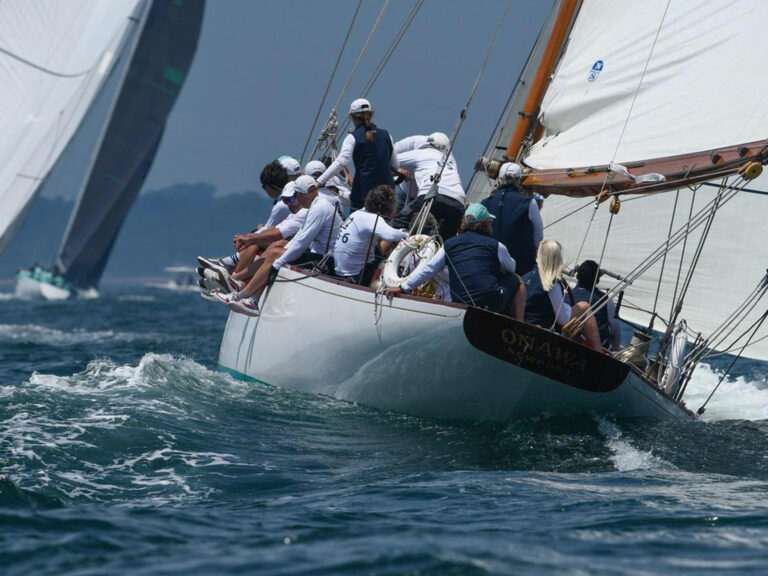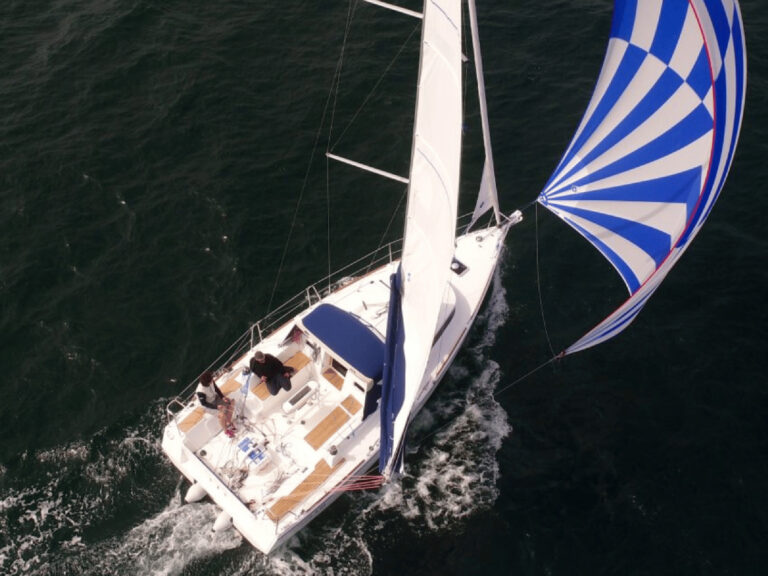
“Hurricane coming,” Ray Pentrack quipped as I passed him in the Cruz Bay grocery store. He was the manager at Cruz Bay Marina on St. John in the US Virgin Islands. I had just flown in from Maine, looking forward to a few weeks on my boat before hauling out for hurricane season.
“What hurricane?” I asked.
“Hurricane Hugo,” Ray said. “It’s going to be a whopper. Category 3. We have our hands full. Can you take care of your boat?”
Afaran, my Lord Nelson 41 cutter, had spent the summer on a mooring in nearby Great Cruz Bay.
“Sure, but when?”
“It should make landfall on Guadeloupe tomorrow, and then hit us sometime on Monday. Many of the boats are heading for Hurricane Hole at the east end of the island.”
This was the first summer I’d left Afaran in the Caribbean, on a rented mooring, instead of sailing back to Maine with the seasons. Now my mind went into hyperdrive. Was Afaran ready for this? Was I ready?
I had an idea of what it was like to live through a hurricane. Two years earlier, in September 1987, Afaran and I had managed to ride out Hurricane Emily in Bermuda—barely—thanks to my 75-pound fisherman-style storm anchor. Afaran’s working anchor was a 65-pound CQR on 300 feet of chain. I had a 45-pound Danforth too. Enough?
The bigger question was whereto anchor Afaran. I’d just have to go look.
I loaded the shopping cart with extra jugs of water, bread, canned goods, frozen chicken, peanut butter, jam, UHT milk and cereal. By late afternoon, I was moving it all onto Afaran’s deck.
Next, I unlocked and opened the companionway, shoved back the hatch, and went below to inspect the bilge. It was dry. I then prepared the boat to get underway as the VHF radio’s weather channel droned in the background.
“Hurricane Hugo will pass near or over Guadeloupe Saturday night. Winds are predicted to be in excess of 140 knots, seas to 20 feet, with a storm surge of 3 feet or more. On Sunday evening, we expect Hurricane Hugo to pass over the Virgin Islands as a Category 3. All mariners are urged to make all necessary preparations for a very dangerous storm.”
It was like listening to a judge hand down your life sentence. I seesawed between thrill and dread—excitement for the challenge and fear of the disaster—as I removed all the sails and stowed them below.

Eventually, I turned on the running lights and motored out of Great Cruz Bay. At the beach off the Caneel Bay Resort, I dropped the hook for the night.
Saturday, September 16
As Afaran rounded Privateer Point at the east end of St. John, I could see a few boats anchored in Hansen Bay. Up in Hurricane Hole, I saw dozens of boats squeezing in, bows riding to anchors, crews tying off stern lines to the mangroves and then rigging fenders. The scene looked like a boat show. It was too crowded.
I motored over to Coral Bay Harbor, where the large anchorage was surprisingly unpopulated. With an eye on the sounder, I picked a midharbor spot in 15 to 20 feet of water. I dropped and set the CQR, then dived over the side to inspect. Sand had buried the plowshares, while the shank and chain rested on the seabed. No coral heads or rocks to foul the anchor lines or chain.
With no breeze, it was hot, sweaty work. I rigged the 75-pound fisherman-style storm anchor, this time securing two nylon rodes to the 30 feet of chain. I let one line slack to take up the strain as the first one stretched out. I slipped the anchor over the side into the dinghy, motored out and set it, creating a V with the chain on the CQR. To mark each anchor’s position, I buoyed each with an empty gallon water jug. This, I figured, would alert others not to anchor between them.
Next, I spliced a thimble into one end of a 30-foot nylon snubbing line, shackled it to the anchor chain, slipped a 3-foot length of reinforced hose on for chafing gear, tied off the bitter end on the Samson post, and then let out 10 more feet of chain, allowing the snubber to take the chain’s weight. Now, before the chain became taut, the nylon line would stretch out, cushioning the CQR anchor.
I rigged chafing gear on the two rodes that ran over the bronze rollers on the bowsprit to the fisherman-style anchor, then deployed a third anchor off the port quarter, just in case. I stowed all the deck gear below but decided to leave the dodger in place, giving me a place to hide out of the wind.
While wolfing down a PB&J sandwich at lunch, I listened to a commercial radio station on St. Thomas. Hugo would hit Guadeloupe that night with wind gusts up to 140 mph. We would begin to feel the effects of the storm the next evening. We could expect winds over 100 mph, with gusts to 140.

Toward evening, with little left to do, my concern turned to worry, and then anxiety. My mouth was dry. A knot grew in my belly. My mind raced with disaster scenarios. A chain link would part. An anchor would break out. Afaran would be driven into the mangroves astern. Another yacht would drag down on us, entangling its anchor line with mine. The hulls would smash, with the storm dragging both boats to the beach.
Then my rational brain spoke up. When in trouble, what do you do? Seek local knowledge. I needed to talk to someone.
It was happy hour ashore at Skinny Legs Bar and Grill. I pulled up a stool next to someone I knew: a burly Kiwi named Derek. He was the mechanic at Cruz Bay Shipyard who had worked on my boat. Seated on the opposite side were his wife and teenage daughter. They lived in Coral Harbor on their 50-foot ketch, which was anchored on the other side of the harbor from me.
“How can anyone expect to survive a hurricane like this?” I asked.
“It can be done,” Derek said, slowly nursing a Red Stripe.
“It blew 115 knots during Hurricane Emily two years ago when I was in Bermuda,” I said. “It lasted only two hours, but that was enough for me. It’s supposed to blow 140 knots, and for 10 to 12 hours. I don’t see how any boat can survive.”
“Go forward every half-hour and inspect the chafing gear.”
“How can you see anything when the wind blows rain in your face at 100 miles an hour?”
“Use a mask and snorkel.”
That sounded reasonable.
He added: “Most of the damage done to boats at anchor or on a mooring during a storm comes from lines that chafe through.”
I had one more question, as I glanced at his wife and daughter: “Are you staying on your boat or going ashore?”
“Stay with your boat,” he said. “Protect your boat—it’s your home. Just check the chafe gear every half-hour. It’s the one thing you can do to ensure that you have a boat the next day.”
I ordered Derek another Red Stripe, and all four of us tucked into a dinner of conch fritters and fries at the bar.
Later, under an almost full moon, I removed my dinghy’s outboard engine, secured it in the cockpit, and hauled the dinghy on deck, deflated it, and packed it in its bag, securing it to the life raft just forward of the mast. Then I crawled into my bunk.
The night was full of dreams—huge waves, pounding surf—and the feeling of being underwater, rolling around.

Sunday, September 17
The day was still and hot. There was nothing more I could think to do. I sat on the foredeck, reading Tom Clancy’s The Cardinal of the Kremlin. As more boats arrived, I shooed away those attempting to anchor in front of me.
In the afternoon, high, thin clouds began to cover the eastern sky. The land-based AM radio stations were full of news. Hugo had crossed over Guadeloupe the night before, with winds over 140 miles per hour, 20-foot waves and a 2- to 3-foot surge. A dozen people were killed. Hugo’s expected path would bring it directly over the Virgin Islands from that night until the next morning.
By dusk, more than 50 boats were anchored all around me in Coral Bay. Some people dropped a single anchor, left their sails on, jumped into their dinghy, and went ashore. Few stayed aboard.
As dusk arrived, so did the tendrils of wind, sweeping down from the sky to hit the water at the far edge of the moored fleet and then shoot across the harbor, tearing up the water, kicking up spray and knocking boats flat. It went roaring up the hillside, stripping leaves from the trees. It left a brown path of snapped trees and torn-up brush in its wake.
This went on as darkness fell. I sat on the life raft and watched.
Then the rain began—not all at once, but in fits and starts, along with the wind that came and went. I went down and stuffed a can of warm beef stew into my stomach. I put on my foul-weather jacket, pulled the hood over my head, and strapped on my dive mask to keep the hood in place. I was not about to leave my bald head unprotected.
I would be spending the entire night on the foredeck, crammed in between the windlass and the bulwarks, out of the wind.
By 10 p.m., we were in it. The winds initially came from the east, then gradually shifted to the south as Hugo’s eye slowly moved northwestward, passing just 30 miles south of us, over St. Croix.
Gusts blew well over 100 knots. By 2 a.m., we had 5- to 10-foot swells entering the harbor. Afaran rose to meet each swell, only to plunge into the steep troughs. I worried that we might hit the bottom, but the surge had increased the water’s depth. We bottomed out only twice, with a thud.
I lay on the deck, in the dark, the wind shrieking through the boat’s rigging, the air full of rain and spray blown off the tops of breaking waves. A gust would hit the boat, and it would rear back like a horse trying to shake the halter. With my flashlight, I watched as the nylon lines stretched out. Then, when the gust retreated, Afaran would surge forward, the stretched-out nylon rodes acting like rubber bands. The lines hung limp off the bow rollers until the next gust drove us back.

Every 15 minutes, I turned on my flashlight and inspected the rodes and chafing gear. I was gratified to watch the bronze bow rollers as the rodes and snubber line stretched out. This minimized friction compared with stationary chocks.
Occasionally, the night was ablaze with light. Derek, on his boat, had fired up his big searchlight and was sweeping the harbor to see what was happening. I raised my head above the gunwale to follow the light. Each sweep saw an increasing number of yachts piled up on the beach.
On deck, the noise was deafening, like standing on a New York City subway platform as the express roared through. Every hour or so, I crawled back to the cockpit to check the windspeed. Steady at 100 knots.
Descending below, I found the cabin alarmingly serene compared with the hell up on deck. I’d drink water and tap the barometer. The needle would jump down—the hurricane was still advancing on us.
By 3 a.m., things were at their worst. Derek’s spotlight revealed that more of the anchored boats were missing. The 90-foot Bermuda yacht had taken two others ashore with it.
By 5 a.m., it was getting lighter. At 7 a.m., I could stand on deck. I removed my mask and snorkel, and looked around.
There had been 55 boats anchored in Coral Bay. I counted only five of us still riding to our anchors. The mangroves and the beach road were lined with boats, two and three deep.
At 9 a.m., it was all over. The wind stopped. The sun came out.
It had been 12 hours. Hurricane Hugo had left the building.
My boat never lost electrical power, refrigeration, music or a working stove. As Afaran and I cruised from island to island, we were alone. For a week, I saw no other boats underway. It felt as if we were the last boat left in the world.
Editor’s Note: Six years after Hurricane Hugo, Lyman rode out Hurricane Luis aboard Afaran at anchor in Mayo Bay, in St. John, USVI, before Hurricane Marilyn finally took Afaran, leaving behind only the mast, engine and pieces of the hull no larger than a refrigerator door. Lyman was not aboard during that storm.

